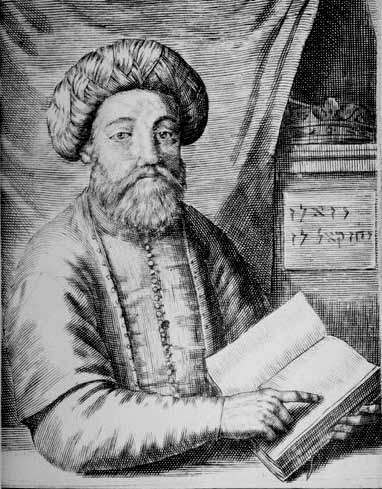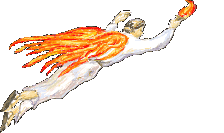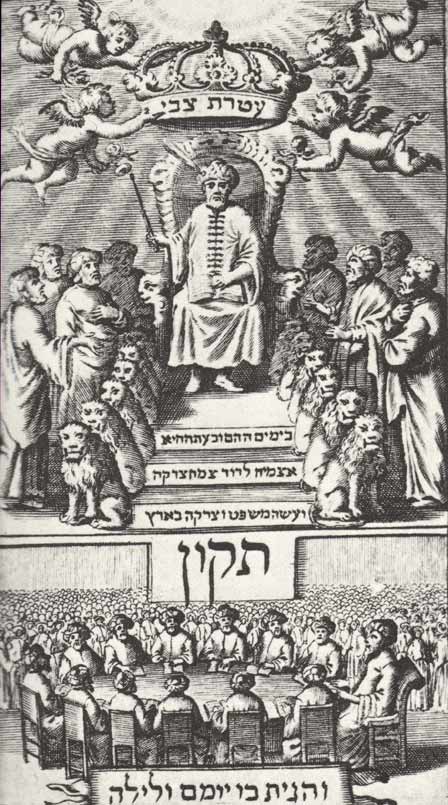|
Biblical difficulties include the fact that the Messiah must be
Jewish: “Their nobles shall be from among them, and their governor shall come from their midst;
then I will cause him to draw near, and he shall approach Me; for who is this who pledged his heart to approach Me?’ says the Lord.
‘You shall be My people, and I will be your God.’”
(Jeremiah 30:21-22).
This is a general rule for choosing a king over Israel:
“When you come to the land which the Lord your God
is giving you, and possess it and dwell in it, and say, ‘I will
set a king over me like all the nations that are around me,’ you
shall surely set a king over you whom the Lord your God chooses;
one from among your brethren you shall set as king over you; you
may not set a foreigner over you, who is not your brother.”
(Deuteronomy 17:14-15).

Serene
Serene appeared in Syria in the eight century A.D.:
"Natronai states in his responsum (l.c.) that
Serene represented himself as the Messiah, establishing certain
religious observances opposed to the rabbinical law, abolishing
prayer, neglecting the laws of "terefah," not guarding the wine
against "nesek," working on the second holy day, and abolishing both
the ketubah and certain incest laws established by the scribes.
"The date of Serene's appearance is given by Isidor Pacensis ("Chronicon,"
in Florez's "Espaņa Sagrada," viii. 298) as 103 of the Hegira (c.
720 C.E.), which was during the reign of Yazid II. This same
historian states that in Spain many Jews abandoned all their
property and prepared to join the supposed Messiah. The latter,
indeed, owing to his promise to put the Jews in possession of the
Holy Land, and, perhaps, owing to his hostility toward the Talmud,
gained many adherents. He was finally captured and taken before
Yazid II., who put some questions to him concerning his Messianic
qualities which he was unable to answer. He declared that he had
never had any serious design against the calif, and that he desired
only to mock the Jews, whereupon he was handed to the latter for
punishment. His adherents, having repented of their credulity, on
the advice of Natronai Gaon were received again into their
communities." (Jewish Encyclopedia, 1906
online, Article "Serene.")
How did Serene expect his scattered people to gather from the ends of the
earth and assemble in Jerusalem? They would fly upon a cloud, of course:
"The same motif already had occurred in an earlier
messianic movement, inspired by a certain Serenus (?). The
fragmentary references to this movement, which occurred in the
Orient at the beginning of the eighth century, indicate that the
Jews expected to fly through the air to Jerusalem." (Gershom Scholem,
'Sabbatai Sevi: the Mystical Messiah,' p. 595).
A later movement in Baghdad, in the first half of the twelfth century,
specifies angel wings as the mode of transport:
"'They [the Jews of Baghdad] gave a great part of their
property to charity, prepared green garments for themselves, and
assembled on the appointed night on the roofs of their houses, where
they waited for the angels that would carry them to Jerusalem on
their wings.' For a long time, that year was referred to as 'the
year of the flight' by the Jews of Baghdad." (Gershom Scholem,
'Sabbatai Sevi: the Mystical Messiah,' p. 595).
Some readers profess to be astonished at the idea that the Messiah
might make any sort of change to the law, yet Serene, like Jesus of
Nazareth, was a legal reformer:
"One formidable protest came early in the eighth century
when a certain Serene proclaimed himself, in Syria, as the
long-awaited Messiah, divinely ordained to expel the Moslems from
the Holy Land. He released his followers from dependence upon the
Talmud, abolishing the dietary laws, the regulations that governed
the holidays, and the other practices which, he thought, pressed
heavily on the people. Serene gained thousands of adherents, and his
fame spread as far as Spain. He was soon captured, however, by the
caliph, Yazed II, who turned him over to the Jews for punishment and
thus effectively ended his Messianic pretensions."
(Abram Leon Sachar, A History of the Jews, p. 162).
Notice that several of the 'things which never happen' happen here: the 'Messiah' changes the law,
and is opposed by the religious authorities. Realizing that some
critics feel free to toss out the historical accounts, the gospels,
because they include 'things which never happen,' it is refreshing
to discover how often these features do occur. Of course, a
Messianic aspirant who is false, who is deceiving the people, is a
threat to public safety as well as soul destroyer,— in the
eighth century as in the first.

David Alroy
"A pseudo-Messiah who lived about 1160; born at Amadia in Kurdistan. He became thoroughly proficient in Biblical and Talmudic knowledge, studying under
Hisdai, the Prince of the Exile, and under Ali, the head of the
Academy in Bagdad. . .The materials for a rebellion being thus at hand, David Alroy raised the banner of revolt against the Seljuk Sultan Muktafi, and called upon the oppressed people of Israel to regard him as their long-expected Messiah. He promised to lead his brethren to the recapture of Jerusalem, after which he would be their king, and they would forever be free. In the adjacent district of Adherbaijan there lived a number of warlike Jews who had their homes among the mountains of Chaftan, and these men Alroy sought to win over to his cause. To his brethren in Mosul, Bagdad, and other towns, he sent letters announcing his divine mission, and summoning them to aid him in waging war upon the Moslems and to shake off their yoke. His intimate knowledge of the magic arts is said to have convinced many Jews of the truth of his pretensions, and Alroy soon found himself with a considerable following, burning to free themselves from Moslem tyranny. He resolved to attack the citadel of his native town, Amadia, and directed his supporters to assemble in that city, with swords and other weapons concealed under their robes, and to give, as a pretext for their presence, their desire to study the Talmud with such a distinguished scholar as himself."
(Jewish Encyclopedia, Article "David Alroy," 1906 edition
online.)
The details of what happened next are somewhat sketchy.
Suffice it to say, he was not successful, though he did
evidently succeed in leaving a sect of "Menahemites" to revere
his memory. He was the kind of 'Fighting Messiah' close to Rabbi
Boteach's heart; but who has heard of him? And who has not heard
of Jesus?

Abraham ben Samuel Abulafia
Abraham ben Samuel Abulafia claimed to be the Messiah in the
thirteenth century: "Preaching asceticism and the highest potentiality of the spirit through communion with God, effected by a perfect knowledge and use of His names, he was thoroughly convinced of his prophetic mission, and considered himself to be the God-sent Messiah and Son of God."
(Jellinek, cited in Jewish Encyclopdia article on
Abraham ben Samuel Abulafia). This Kabbalist pioneer first went looking for the ten lost
tribes: "At the age of eighteen he was wandering eastward in search
of the river Sambation, by the banks of which the lost ten tribes of
Israel were reputed to dwell, awaiting the coming of the Messiah."
(Abram Leon Sachar, A History of the Jews, p. 234).
Failing to find them, he returned. No shrinking violet,
he went straight to the top:
"Abulafia soon left Spain again, and in 1279 wrote at
Patras, in Greece, the first of his prophetic books, "Sefer ha-Yashar"
(The Book of the Righteous). In obedience to an inner voice, he went
in 1280 to Rome, in order to effect the conversion of Pope Nicholas
III. on the day before New Year, 5041. The pope, then in Suriano,
heard of it, and issued orders to burn the fanatic as soon as he
reached that place. Close to the inner gate the stake was erected in
preparation; but not in the least disturbed, Abulafia set out for
Suriano and reached there August 22. While passing through the outer
gate, he heard that the pope had succumbed to an apoplectic stroke
during the preceding night. Returning to Rome, he was thrown into
prison by the Minorites, but was liberated after four weeks'
detention. He was next heard of in Sicily, where he appeared as a
prophet and Messiah. This claim was put an end to by a letter to the
people of Palermo, which most energetically condemned Abulafia's
conduct. It was written by R. Solomon ben Adret, who strove with all
his power to guide men's minds aright in that trying time of
hysterical mental confusion. Abulafia had to take up the pilgrim's
staff anew, and under distressing conditions compiled his "Sefer ha-Ot"
(The Book of the Sign) on the little island of Comino, near Malta,
1285-88. In 1291 he wrote his last, and perhaps his most
intelligible, work, "Imre Shefer" (Words of Beauty); after this all
trace of him is lost." (Jewish Encyclopedia, 1906 edition
online, Article Abraham Abulafia).
If you can't be good, it's good to be lucky, I guess.

Asher Lemmlein
The 'John the Baptist' of an unknown, and no-show, 'Messiah' who was to appear that very year:
"Pretended forerunner of the Messiah. He appeared in
Istria, near Venice, in 1502, and announced the coming of the
Messiah in that very year, provided the Jews showed repentance and
practiced charity. Having gained many adherents in Italy, Lemmlein
traveled through Austria and Germany, receiving there both sympathy
and credence. . .There were much fasting, much praying, and much
distribution of alms wherever Lemmlein passed, so that the year of
his propaganda was called the year of penitence. But he suddenly
disappeared; and the agitation came to an end." (The Jewish
Encyclopedia, 1906 edition,
online, Article "Lemmlein, Asher").
Maybe he made enough money to retire to the country-side. Maybe he's in occultation.

Solomon Molko
A rare treat, a Christian revert, — although the Marranos
were not really converts in the first place, or at least were questioned. He had been attracted by
David Ha-Reubeni, a self-proclaimed king who cagily refused to
say that he was the Messiah, but after his self-circumcision proved
unpopular, he became disillusioned: "Reubeni's appearance
stirred the latent mysticism of a young marrano of excellent family,
Diego Pires, who was serving as royal secretary in a high court of justice. He had immersed himself in the Cabala and was thoroughly
convinced that the Messianic era was at hand. He sought out Reubeni,
but the wily charlatan refused to interview him. Diego attributed
the rebuff to the circumstance that he was a marrano, living in
falsehood and sin. He returned to Judaism, adopted the name of
Solomon Molko, submitted to circumcision, saw visions in which he
was commanded to preach the coming of the Messiah, and secretly left
Portugal." (Abram Leon Sachar, A History of the Jews, p. 159).
He too turns up at Rome, and pantomimes the famous Talmudic vignette
of the leper Messiah:
"I questioned him further when the Messiah will appear.
And he answered: Go and ask him himself. 'But where is he to be
found?' 'At the gate of Rome, among poor people inflicted with
wounds.' 'And how can I recognize him?' All the inflicted poor open
the bandages of all their wounds, fix all of them and then dress them.
And he opens one bandage, fixes the wound and dresses it, and then
goes on to the next one, for the reason that perhaps he will be cold
and there will be a delay till all the wounds are dressed." (The
Babylonian Talmud, edited by Michael L. Rodkinson, Volume XVI, Tract
Sanhedrin, Chapter XI, Kindle location 65142).
Like the man says, "He [Solomon Molko] preached to vast audiences of wondering Jews and in 1529 arrived outside of Rome. In
conformity with the Messianic tradition, he remained in rags for a
month, among the poor and the leprous, and then, starved and worn by
his self-inflicted privations, he entered the city of wickedness."
(Abram Leon Sachar, A History of the Jews, p. 239). This looks like
symbolic speech. At first the pope protected him:
"Notwithstanding this, and his notorious apostasy, when he came to Rome in 1529, Pope Clement expressly protected him from the Inquisition. He seemed to have prophesied – as ‘the destruction of Edom’ – the month and year in which Rome would be sacked: 1527. Now he lived with the beggars on a bridge over the Tiber and predicted the river would flood, as it duly did in October 1530."
(Schama, Simon. The Story of the Jews:
Finding the Words 1000 BC-1492 AD (p. 591).)
Why do these people feel the need to visit the pope? He fell into the hands of the Inquisition, — he was, after all, a
lapsed Catholic. "This was all the more startling because, technically
and legally, Solomon was himself a heretic Christian who had not
only committed the unforgivable sin of relapsing into Judaism but
spent the rest of his life aggressively Judaising. This made him
prime bait for the Inquisition, and once informed on, he was
surrendered to its ordeals. There was nothing his papal protector
and patron could do about that. . .The pyre was stacked and kindled
and Solomon Molkho was burned upon it." (Schama,
Simon. The Story of the Jews: Finding the Words 1000 BC-1492 AD (p.
592).) Or is it possible another was substituted?
Solomon and David Ha-Reubeni joined up together again: "But no
writer of the fantastic could devise an ending more extraordinary
than the one Prince David and Solomon the king wrote for themselves.
Their paths crossed once more in Italy, probably sometime in 1532
when both might have been expected to be looking for refuge rather
than yet more opportunities to promote the grand design of Jewish
redemption. . .In 1532, the two embodiments of Jewish hope and
redemption – the prince and the Messiah – notwithstanding frantic
attempts to deter them, travelled to Regensburg in Bavaria, where
Charles V had convened the Imperial Diet. Such an encounter had its
perils, they conceded, but both had consulted the planetary
alignments and this was definitely the prime moment to move the
messianic timetable along. They would urge the emperor to make haste
in his war against the sultan." (Schama, Simon.
The Story of the Jews: Finding the Words 1000 BC-1492 AD (pp.
592-594).) In spite of their high hopes, this did not go
well. The two men fit in different pigeon-holes; Ha-Reubeni was not
a revert, and thus did not fall directly under the jurisdiction of
the Inquisition. Still both men ended up being burned at the stake.

Sabbatai Sevi
Like Jesus of Nazareth, who lays claim to over two billion souls
in the world today, Sabbatai Sevi still has followers: the people
called the Donmeh in Turkey, who practice a syncretistic religion
incorporating his Messianic claims. Some elements of this Messianic
movement are familiar to Christians: Sabbatai Sevi sent twelve
apostles, his prophet Nathan of Gaza preached a gospel of
justification by faith, and the Messiah proclaimed his ability to
forgive sins. One glaringly discordant element: Sabbatai Sevi was a Kabbalist.
The Kabbalah is a medieval revival of gnosticism, which recasts this
world, not as the deliberate, willed creation of a transcendent God,
but the involuntary result of a series of emanations which, after an
unintended accident called the 'breaking of the vessels,' left us
with this world we see around us: a 'Super-fund' clean-up project,
which requires human effort to make right. Indeed it is up to
humanity to repair not only the world but also God Himself, who was
broken in the disaster that led to the formation of the world. This
clean-up project magnifies man, making him into a sort of
'God-maker:'
"The Zohar says that every time we choose to subdue and
subjugate evil, God’s glory rises higher." (Boteach, Shmuley
(2011-12-07). Kosher Jesus (p. 204). Gefen Publishing House. Kindle
Edition.)
More precisely, it is some men, Israel, who make it their business
to 'raise the sparks,' bits and pieces of the divine which have fallen
into the pit: "Israel's task, according to the kabbalists, was
not to be a light to the nations but, on the contrary, to extract from
them the very last sparks of holiness and life." (Gershom Scholem,
Sabbatai Sevi: The Mystical Messiah, p. 46). Readers familiar with
earlier forms of gnosticism like the Valentinian system will notice
'Israel' have been substituted for the 'spiritual' upper-crust, while
the lower, bestial, altogether unredeemable carnal half-men are now
'Gentiles.' Other than that, it's standard-brand gnosticism. Like other Kabbalists, this group believed in an infinite, unbounded, unknowable
deity, Ein Sof, with which mankind can make no contact, who then 'emanated'
a set of personal attributes by which he can be known and, indeed,
manipulated. These are the ten aeons or sefirot. This is not polytheism because the 'water' in the
'vessels' is the same water: "The explanation is this. Know that the
supernal [world of ] Emanation [that is, the sefiroth of the Godhead]
is like unto the great sea. The water at the shore is the same as that
in the middle of the sea, and all are one. Even so it is with His
Emanation." (Gershom Scholem, Sabbatai Sevi: The Mystical Messiah, p. 316). The Kabbalah proclaims the
'good news' that God is broken and in need of repair by human hands:
|
















